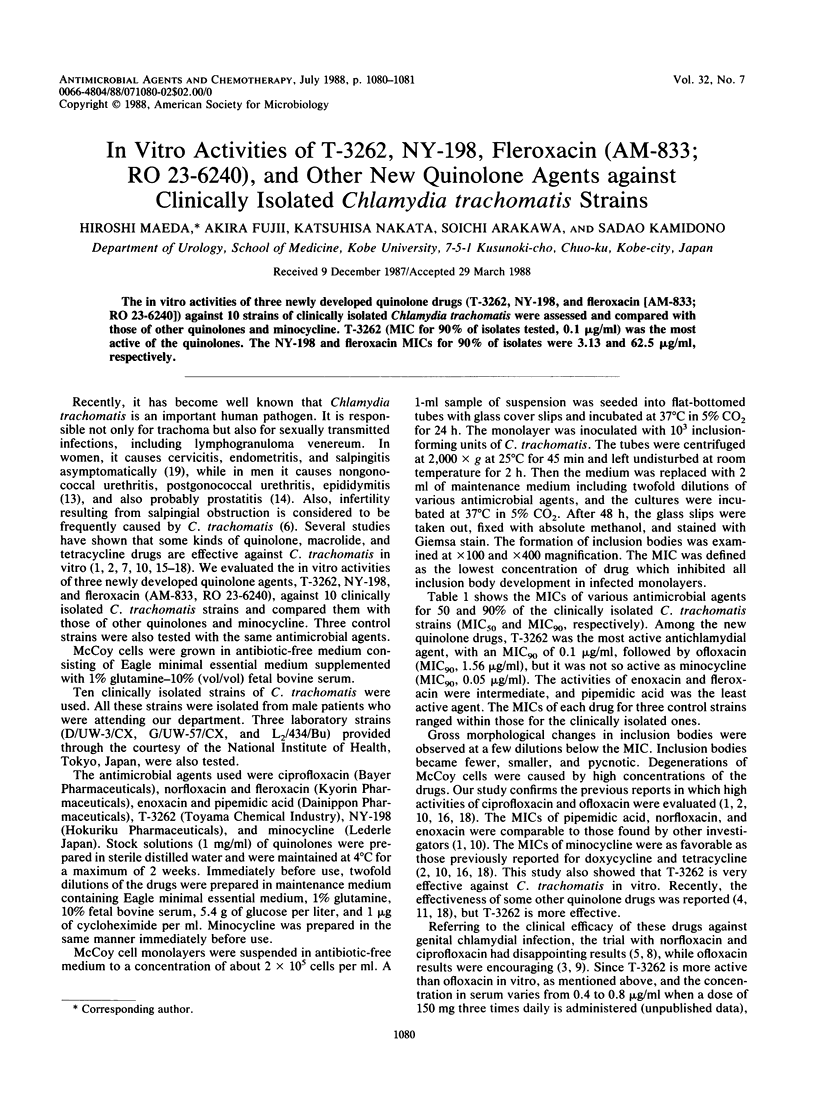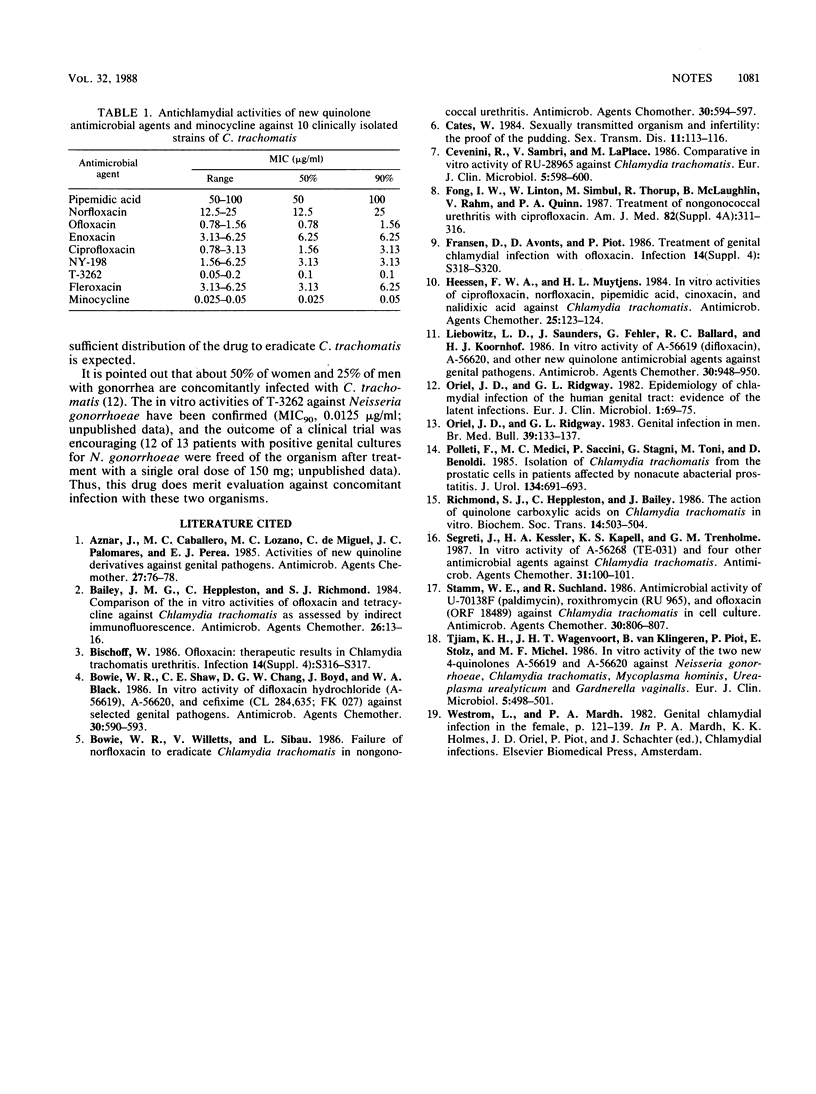Abstract
The in vitro activities of three newly developed quinolone drugs (T-3262, NY-198, and fleroxacin [AM-833; RO 23-6240]) against 10 strains of clinically isolated Chlamydia trachomatis were assessed and compared with those of other quinolones and minocycline. T-3262 (MIC for 90% of isolates tested, 0.1 microgram/ml) was the most active of the quinolones. The NY-198 and fleroxacin MICs for 90% of isolates were 3.13 and 62.5 micrograms/ml, respectively.
Full text
PDF

Selected References
These references are in PubMed. This may not be the complete list of references from this article.
- Aznar J., Caballero M. C., Lozano M. C., de Miguel C., Palomares J. C., Perea E. J. Activities of new quinoline derivatives against genital pathogens. Antimicrob Agents Chemother. 1985 Jan;27(1):76–78. doi: 10.1128/aac.27.1.76. [DOI] [PMC free article] [PubMed] [Google Scholar]
- Bailey J. M., Heppleston C., Richmond S. J. Comparison of the in vitro activities of ofloxacin and tetracycline against Chlamydia trachomatis as assessed by indirect immunofluorescence. Antimicrob Agents Chemother. 1984 Jul;26(1):13–16. doi: 10.1128/aac.26.1.13. [DOI] [PMC free article] [PubMed] [Google Scholar]
- Bischoff W. Ofloxacin: therapeutic results in Chlamydia trachomatis urethritis. Infection. 1986;14 (Suppl 4):S316–S317. doi: 10.1007/BF01661306. [DOI] [PubMed] [Google Scholar]
- Bowie W. R., Shaw C. E., Chan D. G., Boyd J., Black W. A. In vitro activity of difloxacin hydrochloride (A-56619), A-56620, and cefixime (CL 284,635; FK 027) against selected genital pathogens. Antimicrob Agents Chemother. 1986 Oct;30(4):590–593. doi: 10.1128/aac.30.4.590. [DOI] [PMC free article] [PubMed] [Google Scholar]
- Bowie W. R., Willetts V., Sibau L. Failure of norfloxacin to eradicate Chlamydia trachomatis in nongonococcal urethritis. Antimicrob Agents Chemother. 1986 Oct;30(4):594–597. doi: 10.1128/aac.30.4.594. [DOI] [PMC free article] [PubMed] [Google Scholar]
- Cates W., Jr Sexually transmitted organisms and infertility: the proof of the pudding. Sex Transm Dis. 1984 Apr-Jun;11(2):113–116. [PubMed] [Google Scholar]
- Cevenini R., Sambri V., La Placa M. Comparative in vitro activity of RU 28965 against Chlamydia trachomatis. Eur J Clin Microbiol. 1986 Oct;5(5):598–600. doi: 10.1007/BF02017714. [DOI] [PubMed] [Google Scholar]
- Fong I. W., Linton W., Simbul M., Thorup R., McLaughlin B., Rahm V., Quinn P. A. Treatment of nongonococcal urethritis with ciprofloxacin. Am J Med. 1987 Apr 27;82(4A):311–316. [PubMed] [Google Scholar]
- Fransen L., Avonts D., Piot P. Treatment of genital chlamydial infection with ofloxacin. Infection. 1986;14 (Suppl 4):S318–S320. doi: 10.1007/BF01661307. [DOI] [PubMed] [Google Scholar]
- Heessen F. W., Muytjens H. L. In vitro activities of ciprofloxacin, norfloxacin, pipemidic acid, cinoxacin, and nalidixic acid against Chlamydia trachomatis. Antimicrob Agents Chemother. 1984 Jan;25(1):123–124. doi: 10.1128/aac.25.1.123. [DOI] [PMC free article] [PubMed] [Google Scholar]
- Liebowitz L. D., Saunders J., Fehler G., Ballard R. C., Koornhof H. J. In vitro activity of A-56619 (difloxacin), A-56620, and other new quinolone antimicrobial agents against genital pathogens. Antimicrob Agents Chemother. 1986 Dec;30(6):948–950. doi: 10.1128/aac.30.6.948. [DOI] [PMC free article] [PubMed] [Google Scholar]
- Oriel J. D., Ridgway G. L. Epidemiology of chlamydial infection of the human genital tract: evidence for the existence of latent infections. Eur J Clin Microbiol. 1982 Apr;1(2):69–75. doi: 10.1007/BF02014194. [DOI] [PubMed] [Google Scholar]
- Oriel J. D., Ridgway G. L. Genital infection in men. Br Med Bull. 1983 Apr;39(2):133–137. doi: 10.1093/oxfordjournals.bmb.a071804. [DOI] [PubMed] [Google Scholar]
- Poletti F., Medici M. C., Alinovi A., Menozzi M. G., Sacchini P., Stagni G., Toni M., Benoldi D. Isolation of Chlamydia trachomatis from the prostatic cells in patients affected by nonacute abacterial prostatitis. J Urol. 1985 Oct;134(4):691–693. doi: 10.1016/s0022-5347(17)47387-3. [DOI] [PubMed] [Google Scholar]
- Richmond S. J., Heppleston C., Bailey J. The action of quinolone carboxylic acids on Chlamydia trachomatis in vitro. Biochem Soc Trans. 1986 Apr;14(2):503–504. doi: 10.1042/bst0140503. [DOI] [PubMed] [Google Scholar]
- Segreti J., Kessler H. A., Kapell K. S., Trenholme G. M. In vitro activity of A-56268 (TE-031) and four other antimicrobial agents against Chlamydia trachomatis. Antimicrob Agents Chemother. 1987 Jan;31(1):100–101. doi: 10.1128/aac.31.1.100. [DOI] [PMC free article] [PubMed] [Google Scholar]
- Stamm W. E., Suchland R. Antimicrobial activity of U-70138F (paldimycin), roxithromycin (RU 965), and ofloxacin (ORF 18489) against Chlamydia trachomatis in cell culture. Antimicrob Agents Chemother. 1986 Nov;30(5):806–807. doi: 10.1128/aac.30.5.806. [DOI] [PMC free article] [PubMed] [Google Scholar]
- Tjiam K. H., Wagenvoort J. H., van Klingeren B., Piot P., Stolz E., Michel M. F. In vitro activity of the two new 4-quinolones A56619 and A56620 against Neisseria gonorrhoeae, Chlamydia trachomatis, Mycoplasma hominis, Ureaplasma urealyticum and Gardnerella vaginalis. Eur J Clin Microbiol. 1986 Oct;5(5):498–501. doi: 10.1007/BF02017690. [DOI] [PubMed] [Google Scholar]


